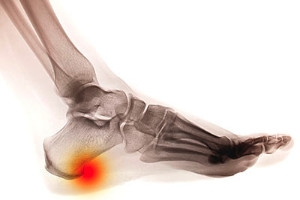
Possible Heel Spur Treatment
 One of the symptoms that is associated with heel spurs is pain in the heel and surrounding areas. The reason this can develop may be inflammation that originates from the plantar fascia, which is the band of tissue that runs along the sole of the foot. Some of the symptoms that are associated with this condition may include heel pain in the morning, or while walking or standing for extended periods of time. There are treatment options available, including resting the foot whenever possible, and performing specific stretches that may loosen the tissues around the heel bone. Some patients find massaging the area is beneficial in finding relief, in addition to wearing shoe inserts. If you have a heel spur, it is recommended that you schedule a consultation with a podiatrist who can offer proper treatment techniques.
One of the symptoms that is associated with heel spurs is pain in the heel and surrounding areas. The reason this can develop may be inflammation that originates from the plantar fascia, which is the band of tissue that runs along the sole of the foot. Some of the symptoms that are associated with this condition may include heel pain in the morning, or while walking or standing for extended periods of time. There are treatment options available, including resting the foot whenever possible, and performing specific stretches that may loosen the tissues around the heel bone. Some patients find massaging the area is beneficial in finding relief, in addition to wearing shoe inserts. If you have a heel spur, it is recommended that you schedule a consultation with a podiatrist who can offer proper treatment techniques.
Heel spurs can be incredibly painful and sometimes may make you unable to participate in physical activities. To get medical care for your heel spurs, contact Joseph D. Ruffo, DPM, PC from New York. Our doctor will do everything possible to treat your condition.
Heels Spurs
Heel spurs are formed by calcium deposits on the back of the foot where the heel is. This can also be caused by small fragments of bone breaking off one section of the foot, attaching onto the back of the foot. Heel spurs can also be bone growth on the back of the foot and may grow in the direction of the arch of the foot.
Older individuals usually suffer from heel spurs and pain sometimes intensifies with age. One of the main condition's spurs are related to is plantar fasciitis.
Pain
The pain associated with spurs is often because of weight placed on the feet. When someone is walking, their entire weight is concentrated on the feet. Bone spurs then have the tendency to affect other bones and tissues around the foot. As the pain continues, the feet will become tender and sensitive over time.
Treatments
There are many ways to treat heel spurs. If one is suffering from heel spurs in conjunction with pain, there are several methods for healing. Medication, surgery, and herbal care are some options.
If you have any questions feel free to contact one of our offices located in Sea Cliff and Babylon, NY . We offer the latest in diagnostic and treatment technology to meet your needs.
Heel Spurs
Heel spurs are the result of calcium deposits that cause bony protrusions on the underside of the heel. Heel spurs are usually painless, but they have the potential to cause heel pain. Heel spurs tend to be associated with plantar fasciitis, which is a condition that causes inflammation of the band of connective tissue that runs along the bottom of the foot. They most often occur to athletes whose sports involve a lot of running and jumping.
Some risk factors for developing heel spurs include running and jogging on hard surfaces, being obese, wearing poorly fitting shoes, or having walking gait abnormalities.
It is possible to have a heel spur without showing signs of any symptoms. However, if inflammation develops at the point of the spur’s formation, you may have pain while walking or running. In terms of diagnosis, sometimes all a doctor needs to know is that the patient is experiencing a sharp pain localized to the heel to diagnose a heel spur. Other times, an x-ray may be needed to confirm the presence of a heel spur.
Heel spurs can be prevented by wearing well-fitting shoes that have shock-absorbent soles. You should also be sure that you are choosing the right shoe for the activity you want to partake in; for example, do not wear walking shoes when you want to go on a run. Additionally, maintaining a healthy weight can be beneficial toward preventing heel spurs, as it will prevent an excess amount of pressure being placed on the ligaments.
There are a variety of treatment options for people with heel spurs. Some of these include stretching exercises, physical therapy, shoe inserts, or taping and strapping to rest stressed muscles and tendons. If you have heel pain that lasts longer than a month, don’t hesitate to seek help from a podiatrist. Your doctor can help you determine which treatment option is best for you.





